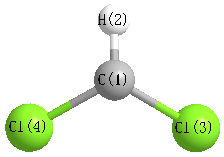Jump to
S1C2
Energy calculated at CCSD(T)/cc-pVDZ
| | hartrees |
|---|
| Energy at 0K | -957.834644 |
| Energy at 298.15K | |
| HF Energy | -957.402187 |
| Nuclear repulsion energy | 124.506314 |
The energy at 298.15K was derived from the energy at 0K
and an integrated heat capacity that used the calculated vibrational frequencies.
Vibrational Frequencies calculated at CCSD(T)/cc-pVDZ
| Mode Number |
Symmetry |
Frequency
(cm-1) |
Scaled Frequency
(cm-1) |
IR Intensities
(km mol-1) |
Raman Act
(Å4/u) |
Dep P |
Dep U |
|---|
| 1 |
A1 |
3273 |
3203 |
|
|
|
|
| 2 |
A1 |
752 |
736 |
|
|
|
|
| 3 |
A1 |
308 |
301 |
|
|
|
|
| 4 |
B1 |
441i |
432i |
|
|
|
|
| 5 |
B2 |
1234 |
1208 |
|
|
|
|
| 6 |
B2 |
936 |
917 |
|
|
|
|
Unscaled Zero Point Vibrational Energy (zpe) 3030.8 cm
-1
Scaled (by 0.9788) Zero Point Vibrational Energy (zpe) 2966.5 cm
-1
See section
III.C.1 List or set vibrational scaling factors
to change the scale factors used here.
See section
III.C.2
Calculate a vibrational scaling factor for a given set of molecules
to determine the least squares best scaling factor.
Geometric Data calculated at CCSD(T)/cc-pVDZ
Point Group is C2v
Cartesians (Å)
| Atom |
x (Å) |
y (Å) |
z (Å) |
|---|
| C1 |
0.000 |
0.000 |
0.680 |
| H2 |
0.000 |
0.000 |
1.772 |
| Cl3 |
0.000 |
1.489 |
-0.172 |
| Cl4 |
0.000 |
-1.489 |
-0.172 |
Atom - Atom Distances (Å)
| |
C1 |
H2 |
Cl3 |
Cl4 |
| C1 | | 1.0914 | 1.7161 | 1.7161 |
H2 | 1.0914 | | 2.4488 | 2.4488 | Cl3 | 1.7161 | 2.4488 | | 2.9789 | Cl4 | 1.7161 | 2.4488 | 2.9789 | |
 More geometry information
More geometry information
Calculated Bond Angles
| atom1 |
atom2 |
atom3 |
angle |
|
atom1 |
atom2 |
atom3 |
angle |
| Cl3 |
C1 |
H2 |
119.778 |
|
Cl3 |
C1 |
Cl4 |
120.443 |
| Cl4 |
C1 |
H2 |
119.778 |
|
Electronic energy levels
Charges, Dipole, Quadrupole and Polarizability
Jump to
S1C1
Energy calculated at CCSD(T)/cc-pVDZ
| | hartrees |
|---|
| Energy at 0K | -957.836068 |
| Energy at 298.15K | -957.836914 |
| HF Energy | -957.404178 |
| Nuclear repulsion energy | 124.349869 |
The energy at 298.15K was derived from the energy at 0K
and an integrated heat capacity that used the calculated vibrational frequencies.
Vibrational Frequencies calculated at CCSD(T)/cc-pVDZ
| Mode Number |
Symmetry |
Frequency
(cm-1) |
Scaled Frequency
(cm-1) |
IR Intensities
(km mol-1) |
Raman Act
(Å4/u) |
Dep P |
Dep U |
|---|
| 1 |
A' |
3224 |
3155 |
|
|
|
|
| 2 |
A' |
761 |
744 |
|
|
|
|
| 3 |
A' |
554 |
543 |
|
|
|
|
| 4 |
A' |
303 |
296 |
|
|
|
|
| 5 |
A" |
1238 |
1211 |
|
|
|
|
| 6 |
A" |
901 |
882 |
|
|
|
|
Unscaled Zero Point Vibrational Energy (zpe) 3489.6 cm
-1
Scaled (by 0.9788) Zero Point Vibrational Energy (zpe) 3415.7 cm
-1
See section
III.C.1 List or set vibrational scaling factors
to change the scale factors used here.
See section
III.C.2
Calculate a vibrational scaling factor for a given set of molecules
to determine the least squares best scaling factor.
Geometric Data calculated at CCSD(T)/cc-pVDZ
Point Group is Cs
Cartesians (Å)
| Atom |
x (Å) |
y (Å) |
z (Å) |
|---|
| C1 |
0.013 |
0.709 |
0.000 |
| H2 |
-0.538 |
1.656 |
0.000 |
| Cl3 |
0.013 |
-0.174 |
1.484 |
| Cl4 |
0.013 |
-0.174 |
-1.484 |
Atom - Atom Distances (Å)
| |
C1 |
H2 |
Cl3 |
Cl4 |
| C1 | | 1.0956 | 1.7272 | 1.7272 |
H2 | 1.0956 | | 2.4199 | 2.4199 | Cl3 | 1.7272 | 2.4199 | | 2.9688 | Cl4 | 1.7272 | 2.4199 | 2.9688 | |
 More geometry information
More geometry information
Calculated Bond Angles
| atom1 |
atom2 |
atom3 |
angle |
|
atom1 |
atom2 |
atom3 |
angle |
| Cl3 |
C1 |
H2 |
116.224 |
|
Cl3 |
C1 |
Cl4 |
118.505 |
| Cl4 |
C1 |
H2 |
116.224 |
|
Electronic energy levels
Charges, Dipole, Quadrupole and Polarizability
